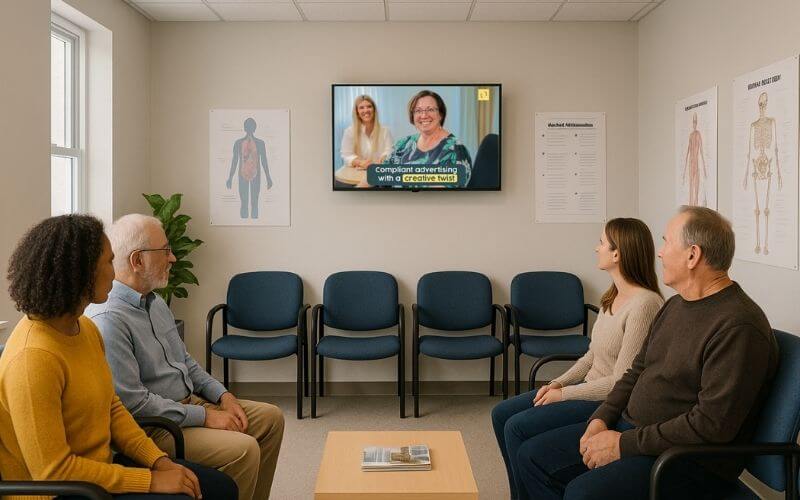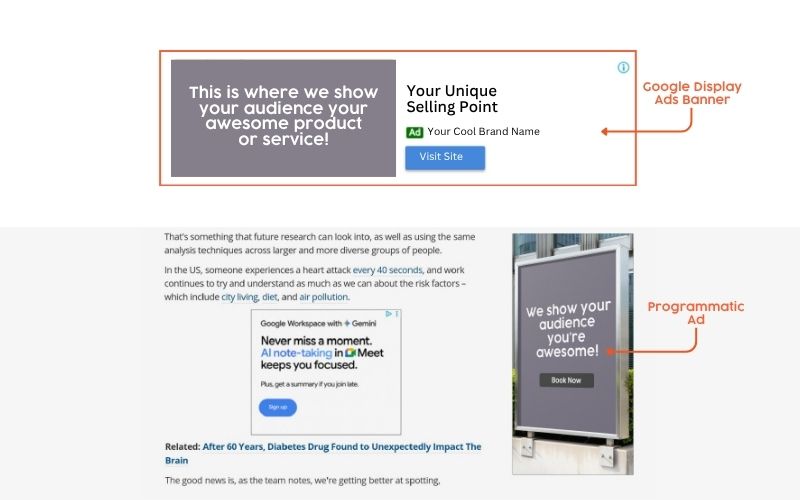Not too long ago, digital marketers could reach highly specific healthcare audiences with ease. Platforms like Meta enabled advertisers to target based on detailed interests, behaviours, and even condition-related topics.
This raised privacy concerns, which have now reshaped the landscape. Meta and other major platforms have tightened restrictions on targeting to reduce the risk of sensitive health data being misused. These changes protect consumers, but they’ve also left healthcare organisations with fewer options to reach relevant audiences in a compliant way.
This is why programmatic advertising has become such a focus in healthcare marketing conversations.
What is programmatic advertising?
Programmatic advertising automates the buying and placement of digital ads. Instead of manual negotiations, data and algorithms decide in real time where your ads should appear, who should see them, and what price you should pay.
For healthcare marketers, this means greater precision, efficiency, and value for money, all while maintaining compliance.
Key features include:
| Automated and manual optimisation | Automation streamlines buying decisions, reduces wasted spend, and continuously adjusts bids to deliver stronger performance, while many different manual adjustments refine audience data, bidding targets and creatives. |
| Data-driven targeting | Analyses real-time signals, such as lifestyle, geography, or specialty affinity, to build highly relevant audience segments. |
| Multi-channel reach | Places ads across environments, including display banners, streaming video, in-app placements, native articles, and connected TV. |
| Actionable reporting | Transparency on where spending goes and how audiences engage, allowing campaigns to be refined in real time. |
| Insights into the consumer journey | Detailed reports on the drop-off funnel show where you’re losing people. |
In short, programmatic ensures the right message reaches the right person at the right time, across their entire digital journey.
Balancing precision with compliance
Programmatic advertising respects privacy while unlocking precision. Platforms rely on anonymised, aggregated data rather than identifiable personal health information. Instead of pinpointing an individual, programmatic identifies groups of users who share similar behaviours or affinities.
For healthcare providers, this balance is crucial: you gain access to advanced targeting while remaining compliant with AHPRA and TGA regulations. It’s a way to achieve meaningful audience reach without compromising ethics or patient confidentiality.
Why programmatic matters more than ever
With Meta campaigns now limited to broad demographics only and Google search campaigns restricted to keyword intent, healthcare organisations risk wasting budget on impressions that don’t connect with the right people.
Programmatic advertising directly addresses that issue, offering compliant, aggregated data signals that can be layered to form highly specific audiences.
Your audience targeting could include:
| Medical specialty affinity | Reach professionals or consumers connected with particular specialties such as cardiology, dermatology or physiotherapy. |
| Chronic condition indicators | Groups likely to be seeking information on long-term conditions like diabetes or arthritis, based on aggregated behaviour data. |
| Lifestyle behaviours | Segment by interest and intent profiles relating to job titles or purchasing intent. |
| Geographic behaviours | Target audiences based on region, postcode, urban vs rural settings, or proximity to relevant healthcare services. |
| Demographic overlays | Refine campaigns by age, gender, or household income. |
| Third-party audience segments | Predefined audience groups based on purchasing and browsing intent. |
Layering these audiences enables you to run highly targeted campaigns.
For example, a Sydney dermatology clinic could target affluent women aged 40–55 on the North Shore who are interested in wellness content and engaging with chronic skin condition information. Meanwhile, a physiotherapy provider in Brisbane could target men aged 30–50 with signals indicating interest in sports injury recovery.
Both campaigns would extend across multiple digital environments, creating relevance and reach that social media alone can’t match. And both businesses would benefit from campaigns that are leaner, smarter and better aligned with commercial goals.
Supporting business objectives across audiences
Programmatic advertising supports tangible business goals across different client types.
If your goal is to win more clients, programmatic enables you to compete on the same turf as much larger businesses. It delivers a measurable return on investment, transparent reporting and more qualified leads.
Programmatic advertising also provides a whole new layer of data optimisation, helping you to learn more about your audience’s reactions and purchasing behaviour, as well as providing insights into where you lose them and what you can do about it.
Once you’ve won clients, you need to retain them. Programmatic enables you to nurture clients beyond Meta and Google, offering more advanced segmentation, sharpening messaging to niche audiences and making budgets work harder.
And it gets better. Programmatic streamlines all your platforms to combine cross-channel marketing strategies. You can integrate data from your CRM directly into the platform to enhance audience targeting and reporting. In a similar vein, you can integrate any e-commerce platforms to enhance data and target specific conversion objectives.
The future of healthcare advertising
As privacy regulations continue to tighten, programmatic advertising will play a central role in healthcare marketing. Its unique combination of compliant precision, cross-channel reach, and real-time optimisation makes it one of the few tools capable of meeting both regulatory requirements and business objectives.
Organisations that embrace programmatic now gain an immediate competitive advantage and safeguard their campaigns against ongoing platform restrictions. Those who delay risk losing reach, wasting spend, and falling behind competitors who have already adopted the model.
How Splice can help
Programmatic advertising is becoming an essential tool for healthcare organisations seeking to maintain relevance and compliance while driving meaningful growth.
At Splice Marketing, we help healthcare providers and brands identify the most valuable audience segments, design compliant campaigns, and measure performance across the entire patient and professional journey.
Book your free strategy session to explore how programmatic advertising could support your growth goals.







